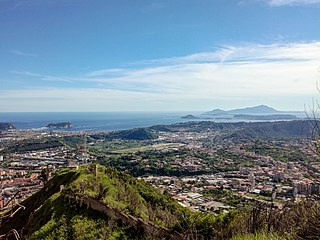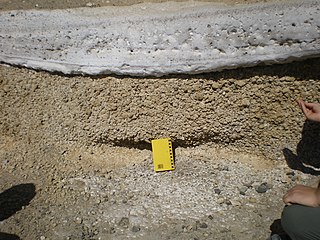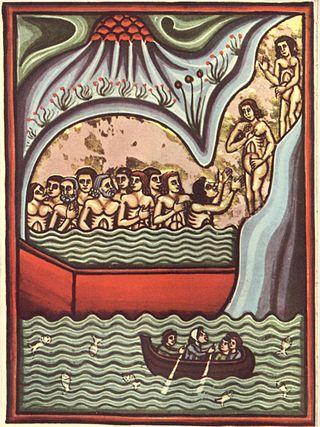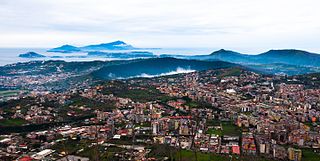
Year 1538 (MDXXXVIII) was a common year starting on Tuesday of the Julian calendar.

Mount Vesuvius is a somma–stratovolcano located on the Gulf of Naples in Campania, Italy, about 9 km (5.6 mi) east of Naples and a short distance from the shore. It is one of several volcanoes forming the Campanian volcanic arc. Vesuvius consists of a large cone partially encircled by the steep rim of a summit caldera, resulting from the collapse of an earlier, much higher structure.

Volcanology is the study of volcanoes, lava, magma and related geological, geophysical and geochemical phenomena (volcanism). The term volcanology is derived from the Latin word vulcan. Vulcan was the ancient Roman god of fire.

Bradyseism is the gradual uplift or descent of part of the Earth's surface caused by the filling or emptying of an underground magma chamber or hydrothermal activity, particularly in volcanic calderas. It can persist for millennia in between eruptions and each uplift event is normally accompanied by thousands of small to moderate earthquakes. The word derives from the ancient Greek words βραδύςbradús, meaning "slow", and σεισμόςseismós meaning "movement", and was coined by Arturo Issel in 1883.

Solfatara is a shallow volcanic crater at Pozzuoli, near Naples, part of the Phlegraean Fields volcanic area. It is a dormant volcano, which still emits jets of steam with sulfurous fumes. The name comes from the Latin, Sulpha terra, "land of sulfur", or "sulfur earth". It was formed around 4000 years ago and last erupted in 1198 with what was probably a phreatic eruption – an explosive steam-driven eruption caused when groundwater interacts with magma. The crater floor was a popular tourist attraction until 2017, as it has many fumaroles and mud pools. The area is well known for its bradyseism. The vapours had been used for medical purposes since Roman times.

The volcanism of Italy is due chiefly to the presence, a short distance to the south, of the boundary between the Eurasian Plate and the African Plate. Italy is a volcanically active country, containing the only active volcanoes in mainland Europe. The lava erupted by Italy's volcanoes is thought to result from the subduction and melting of one plate below another.

The Phlegraean Fields is a large caldera volcano west of Naples, Italy. It is part of the Campanian volcanic arc, which includes Mount Vesuvius, about 9 km east of Naples. The Phlegraean Fields is monitored by the Vesuvius Observatory. It was declared a regional park in 2003.

Shishaldin Volcano, or Mount Shishaldin, is one of six active volcanoes on Unimak Island in eastern the Aleutian Islands of Alaska. It is the highest mountain peak of the Aleutian Islands, rising to a height of 9,373 ft above sea level. Shishaldin's magma supply is generated via flux melting above the Aleutian Trench, where the Pacific Plate subducts beneath the North American Plate. Due to its remote location and frequently inclement weather, the Alaska Volcano Observatory (AVO) monitors the volcano remotely via satellite and a seismic network deployed in 1997. Shishaldin is one of the most active volcanoes in the Aleutian Islands, with 40 confirmed eruptions in the last 11,700 years. Notably, Shishaldin produced a sub-Plinian eruption in 1999.

Graham Island or Isola Ferdinandea was an island in the Mediterranean Sea near Sicily that has, on more than one occasion, risen above the surface of the Mediterranean via volcanic action and soon thereafter been washed away. Since 300 BC this cycle of events has occurred four times. The island was part of the submarine volcano Empedocles, 30 km (19 mi) south of Sicily, which is one of a number of underwater volcanoes known as the Campi Flegrei del Mar di Sicilia.

Piperno is a magmatic rock present in areas where there has been volcanic activity. Piperno abounds in Campania; the areas from which it was obtained were the city of Quarto, Soccavo, Pianura and Nocera Inferiore in the supervolcano region of the Phlegraean Fields. The Piperno layer, with the overlying Breccia Museo, is clearly visible at the base of the Camaldoli hill, in the Soccavo and Verdolino areas.

Empedocles is a large underwater volcano located 40 km (25 mi) off the southern coast of Sicily named after the Greek philosopher Empedocles who believed that everything on Earth was made up of the four elements, and who is said by legend to have thrown himself into a volcano.

The Campanian volcanic arc is a volcanic arc that consists of a number of active, dormant, and extinct volcanoes in the Campania region of Italy. The Campanian volcanic arc centers on the bay of Naples and includes:

Phreatomagmatic eruptions are volcanic eruptions resulting from interaction between magma and water. They differ from exclusively magmatic eruptions and phreatic eruptions. Unlike phreatic eruptions, the products of phreatomagmatic eruptions contain juvenile (magmatic) clasts. It is common for a large explosive eruption to have magmatic and phreatomagmatic components.

Mount Barbaro or Mount Gauro in Italy Monte Barbaro or Monte Gauro, is one of the eruptive vents of the Phlegraean Fields, a volcanic field of Italy located in Campania.
Francesco Signore was an important Italian volcanologist. He began his scientific career as assistant at the "Istituto di Fisica Terrestre", Naples. He served his country during World War I. He was nominated assistant at the Vesuvius Observatory (1928). He taught volcanology at the faculty of science, University of Naples (1934–1956). He was secretary general of the International Association of Volcanology and Chemistry of the Earth's Interior (IAVECI) from 1936 until his death.

The Campanian Ignimbrite eruption was a major volcanic eruption in the Mediterranean during the late Quaternary, classified 7 on the Volcanic Explosivity Index (VEI). The event has been attributed to the Archiflegreo volcano, the 12-by-15-kilometre-wide caldera of the Phlegraean Fields, located 20 km (12 mi) west of Mount Vesuvius under the western outskirts of the city of Naples and the Gulf of Pozzuoli, Italy. It is the largest explosive volcanic event in Europe in the past 200,000 years, and the largest eruption of Campi Fleigrei caldera.

De balneis Puteolanis is a medieval didactic poem in Latin, attributed to Peter of Eboli, describing the thermal baths of Pozzuoli in the Campi Flegrei region of Campania. The poem has the alternative title De balneis terrae laboris.

The 1669 eruption of Mount Etna is the largest-recorded historical eruption of the volcano on the east coast of Sicily, Italy. After several weeks of increasing seismic activity that damaged the town of Nicolosi and other settlements, an eruption fissure opened on the southeastern flank of Etna during the night of 10–11 March. Several more fissures became active during 11 March, erupting pyroclastics and tephra that fell over Sicily and accumulated to form the Monti Rossi scoria cone.

The Phlegraean Fields red zone is the area at greatest volcanic risk in the Phlegraean Fields, in Italy.


















